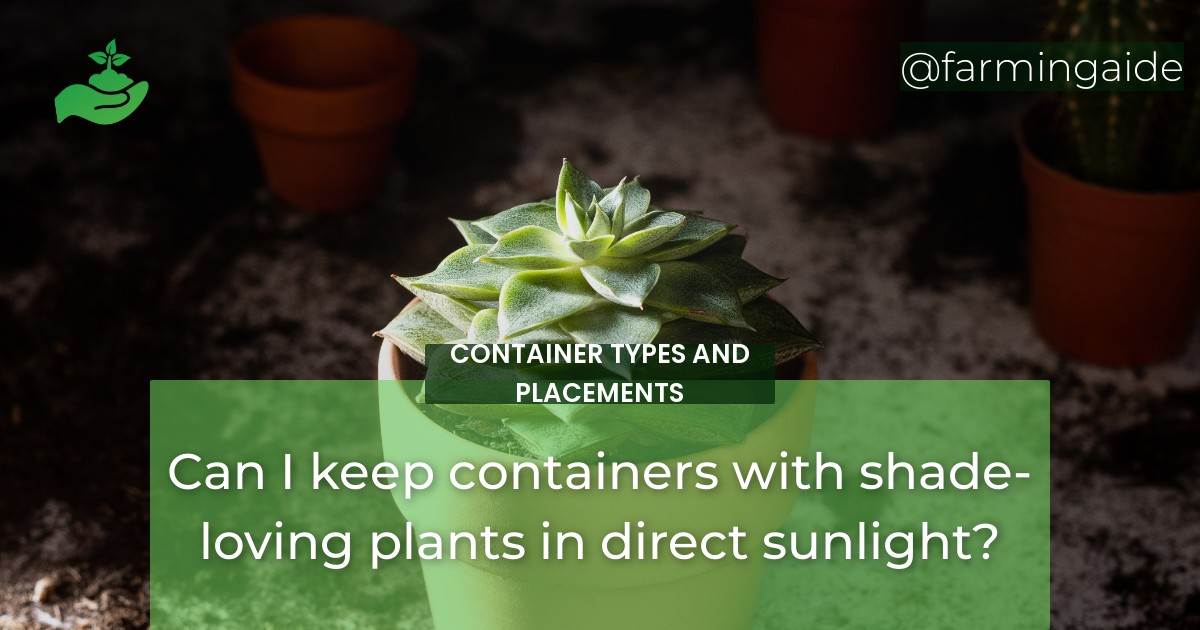Shade-loving plants can be a great addition to your container garden. They can add a pop of color and texture to areas that receive little to no direct sunlight. However, it is essential to understand their light requirements and choose the right container and placement to ensure their survival. The question is, can you keep containers with shade-loving plants in direct sunlight? Let’s dive in and find out.
Understanding Shade-Loving Plants
Characteristics of Shade-Loving Plants
Shade-loving plants, also known as shade-tolerant plants, thrive in low-light conditions and prefer indirect sunlight. They have adapted to grow under the canopy of trees or in areas shaded by buildings and structures. Some of the common characteristics of shade-loving plants are:
- Larger leaves to absorb more light
- Low growth habit to compete for light
- Slower growth rate
- Lower water requirements
- Prefer well-draining soil
Examples of Shade-Loving Plants
Some examples of shade-loving plants that you can grow in containers include:
- Begonias
- Ferns
- Hostas
- Impatiens
- Heucheras
- Lamiums
- Violas
- Caladiums
Light Requirements of Shade-Loving Plants
Shade-loving plants require at least 4 hours of indirect sunlight per day. However, it is important to note that not all shade is created equal. There are different types of shade, including partial shade, dappled shade, and full shade. Partial shade provides 3-6 hours of sunlight, dappled shade occurs when sunlight filters through tree branches, and full shade is when there is no direct sunlight. It is important to choose plants that are suited to the type of shade in your container garden.
Container Types Suitable for Shade-Loving Plants
Choosing the Right Container for Shade-Loving Plants
The right container is crucial for the growth and survival of your shade-loving plants. Here are some factors to consider when choosing a container:
- Drainage: Make sure the container has adequate drainage holes to prevent water from accumulating and damaging the roots.
- Material: Choose a material that is appropriate for the plant’s moisture requirements and the climate in your area. For example, terracotta and clay containers dry out faster than plastic and metal containers.
- Size: Choose a container that is appropriate for the size of the plant and allows room for growth.
Container Materials to Consider
Some container materials to consider for shade-loving plants include:
- Terracotta and clay
- Plastic
- Metal
- Wood
Container Sizes for Shade-Loving Plants
The size of the container depends on the size of the plant. Here are some general guidelines:
- Small plants: 6-8 inch diameter container
- Medium plants: 8-12 inch diameter container
- Large plants: 12-16 inch diameter container
ALSO READ
Container Placement for Shade-Loving Plants
Ideal Placement for Shade-Loving Plants
The ideal placement for shade-loving plants is in an area that receives indirect sunlight. Here are some suggestions:
- North-facing balconies or windowsills
- Underneath trees or large shrubs
- On shaded patios or decks
Factors to Consider for Container Placement
Here are some factors to consider when choosing a location for your shade-loving plants:
- Light: Ensure that the plants receive enough indirect sunlight.
- Temperature: Shade-loving plants prefer cooler temperatures and may wilt or die in hot, sunny areas.
- Wind: Protect the plants from strong winds that can damage the leaves and stems.
Common Mistakes to Avoid
Here are some common mistakes to avoid when placing your shade-loving plants:
- Placing them in direct sunlight
- Placing them in an area with insufficient light
- Placing them in an area with too much wind or hot temperatures
Can Shade-Loving Plants Survive in Direct Sunlight?
The Effects of Direct Sunlight on Shade-Loving Plants
Shade-loving plants are not adapted to direct sunlight and can suffer from leaf scorch, wilting, and stunted growth. They may also become more susceptible to pests and diseases.
Risks of Keeping Shade-Loving Plants in Direct Sunlight
Keeping shade-loving plants in direct sunlight can lead to their death. The plant may not be able to recover from the damage caused by the intense sunlight, and it may also attract pests and diseases.
Alternatives to Direct Sunlight for Shade-Loving Plants
If you do not have an area with indirect sunlight, you can create shade by:
- Using a shade cloth
- Placing the plants under a tree or large shrub
- Planting the plants in a container with a trellis or pergola above it
ALSO READ
Maintaining Shade-Loving Plants in Containers
Watering and Fertilizing Shade-Loving Plants
Shade-loving plants have lower water requirements than other plants, but they still need to be watered regularly. The soil should be moist but not waterlogged. Fertilize the plants once a month with a balanced fertilizer.
Pruning and Trimming Shade-Loving Plants
Prune and trim the plants to remove dead or damaged leaves and stems. This will promote new growth and keep the plant looking neat and tidy.
Preventing Pests and Diseases in Shade-Loving Plants
Prevent pests and diseases by keeping the plants healthy and well-maintained. Inspect the plants regularly for signs of pests or diseases and take action immediately if you see any problems.
Conclusion
Recap of Shade-Loving Plants in Containers
Shade-loving plants can add beauty and interest to your container garden, but they require the right container and placement to thrive. Choose a container with adequate drainage holes and the right material and size for the plant. Place the container in an area with indirect sunlight and protect the plant from wind and hot temperatures. Avoid placing the plant in direct sunlight, as this can lead to damage and death.
Key Takeaways for Container Placement
- Shade-loving plants require at least 4 hours of indirect sunlight.
- Choose a container with adequate drainage holes and the right material and size for the plant.
- Place the container in an area with indirect sunlight and protect the plant from wind and hot temperatures.
- Avoid placing the plant in direct sunlight, as this can lead to damage and death.
RELATED ARTICLES:


